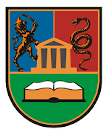Please use this identifier to cite or link to this item:
https://scidar.kg.ac.rs/handle/123456789/21966Full metadata record
| DC Field | Value | Language |
|---|---|---|
| dc.contributor.author | Čebašek, Aleksandra V. | - |
| dc.contributor.author | Kandić, Milica A. | - |
| dc.date.accessioned | 2025-01-22T15:10:37Z | - |
| dc.date.available | 2025-01-22T15:10:37Z | - |
| dc.date.issued | 2024 | - |
| dc.identifier.citation | Слика Берлина: имагинарне и реалне представе мегалополиса у роману „Омама” Слободана Владушића / Александра В. Чебашек, Милица А. Кандић // Савремени токови у изучавању језика, књижевности и културе I / [ed. Ненад Томовић]. - ISBN 978-86-6153-732-5. - Vol. 1 (2024), p. 657–679. | en_US |
| dc.identifier.isbn | 978-86-6153-732-5 | en_US |
| dc.identifier.uri | https://scidar.kg.ac.rs/handle/123456789/21966 | - |
| dc.description | Savremeni tokovi u izučavanju jezika, književnosti i kulture, Zbornik radova sa I naučne konferencije za mlade istraživače i doktorande održane na Filološkom fakultetu u Beogradu 27. i 28. maja 2022. godine, 657-679 | en_US |
| dc.description.abstract | In the paper will be analyzed the image of interwar Weimar Berlin (1928) in Slobodan Vladišić’s novel Omama through the perspective of the two main characters, Miloš Verulović and Miloš Crnjanski. Verulović, a returnee from the war and a hero from Kajmakčalan, has all the signs of post-traumatic stress, which constitutes his perception of the world, his experience of the city and the people around him. The main theme of the novel is the investigation into the mysterious disappearance of a Serbian worker, Milutin Topalović, from the village of Gruža. The search for a worker involves a search through the city – a search for people, streets, neighborhoods, basements - which will raise the issue of the marginalization of the working class in multi-million Berlin. The two heroes - Verulović and Crnjanski, experience Berlin in different ways: while Verulović feels it nostalgically with his whole being, Crnjanski’s experience of Berlin does not seem monstrously apocalyptic to the extent that Berlin is like that in the eyes of Verulović. Therefore, the aim of the work is to present the double representations of Berlin, so it will be referred to both representations of the city – imaginary and real. Berlin will be interpreted through representations of horizontal and vertical images: on the sky-earth plane, but also on the plane of the hero’s spatial movement east-westnorth-south, so Berlin manifests itself twice: as topography and factography; imaginary and fictitious. Based on such a perception of the city, it is possible to talk about the Megalopolis and the ways of its networking, which will raise the question of Berlin as a Megalopolis and reconsider the scope of the observed threads. | en_US |
| dc.language.iso | sr | en_US |
| dc.publisher | Univerzitet u Beogradu, Filološki fakultet | en_US |
| dc.relation.ispartof | Savremeni tokovi u izučavanju jezika, književnosti i kulture | en_US |
| dc.subject | Berlin | en_US |
| dc.subject | Megalopolis | en_US |
| dc.subject | imaginary | en_US |
| dc.subject | real | en_US |
| dc.subject | Omama | en_US |
| dc.title | Slika Berlina: imaginarne i realne predstave megalopolisa u romanu Omama Slobodana Vladušića | en_US |
| dc.title.alternative | THE PICTURE OF BERLIN: IMAGINARY AND REAL REPRESENTATIONS OF MEGALOPOLIS IN THE NOVEL OMAMA BY SLOBODAN VLADUŠIĆ | en_US |
| dc.title.alternative | Слика Берлина: имагинарне и реалне представе мегалополиса у роману Омама Слободана Владушића | en_US |
| dc.type | conferenceObject | en_US |
| dc.description.version | Published | en_US |
| dc.identifier.doi | 10.18485/stijkk.2023.1.ch35 | en_US |
| dc.type.version | PublishedVersion | en_US |
| dc.source.conference | NAUČNA konferencija za mlade istraživače i doktorande Savremeni tokovi u izučavanju jezika, književnosti i kultur (1 ; 2022 ; Beograd) | en_US |
| Appears in Collections: | The Faculty of Philology and Arts, Kragujevac (FILUM) | |
Files in This Item:
| File | Description | Size | Format | |
|---|---|---|---|---|
| Slika Berlina, Čebašek, Kandić.pdf | 350.34 kB | Adobe PDF |  View/Open |
Items in SCIDAR are protected by copyright, with all rights reserved, unless otherwise indicated.

